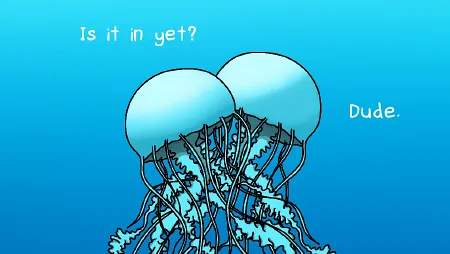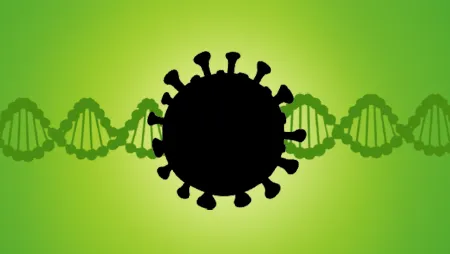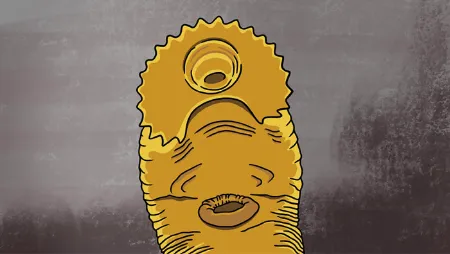What would it take for the parasitic Cordyceps fungus to leap from arthropods to humans and turn us all into saprophytic zombies? Let's find out—preferably by lunch.
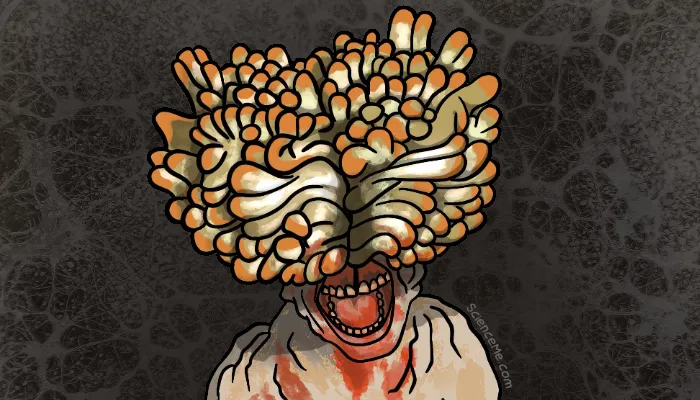
Meet Cordyceps
Cordyceps is a genus of bizarre, beautiful, and devastating fungi. Genetically, they're closer to animals than plants, since both animals and fungi evolved from a common protist ancestor about a billion years ago.
The fungi kingdom further splits into 5-19 major phyla, depending on how you like to slice your pie. Zoom in on sac fungi (ascomycota) and you'll meet budding yeasts, penicillin, and our creepy new friends, the Cordyceps.
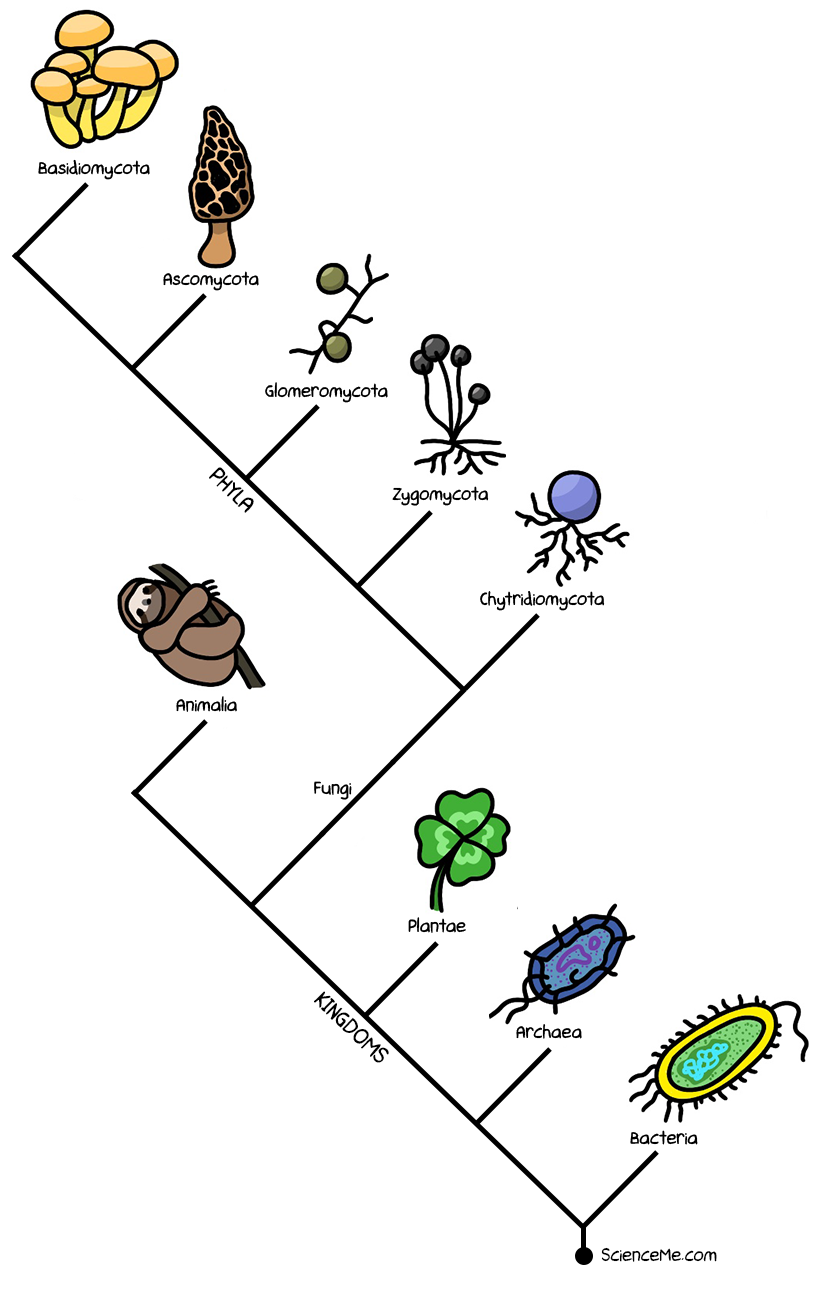
Besides being our evolutionary cousins, fungi also share our animalistic eating habits. As heterotrophs, they get energy by consuming organic matter, as opposed to producing their own through photosynthesis. Specifically, fungi are osmotrophs, secreting enzymes, breaking down complex molecules, and absorbing the nutrient soup.
Fungi have three strange eating habits:
- Parasites extract nutrients from live hosts.
- Saprophytes consume dead or decaying hosts.
- Mutualistic symbionts exchange nutrients with live hosts.
Cordyceps go with two of these: they parasitise the host alive, then turn saprophytic after they kill it (oopsie poopsies). And they do this to an array of insects: cicadas, beetles, butterflies, wasps, ants, and more.
The Discovery of Cordyceps
While travelling in Indonesia in 1859, the naturalist Alfred Russel Wallace had the honour of discovering Ophiocordyceps unilateralis, a Cordyceps species that exclusively feasts on the bodies and brains of carpenter ants.
When an ant becomes infected, he is doomed. The fungus infiltrates his body, spreads to the brain, and begins to puppeteer his behaviour. Soon, the ant abandons the nest and seeks a cool, moist spot ideal for fungal growth. He bites onto the underside of a leaf vein and remains locked there until he dies.
Having consumed the ant's tissues and organs, the fungus is ready to reproduce. It sprouts a creepy little stalk from the corpse which releases spores to infect more ants so the monstrous lifecycle can begin again.
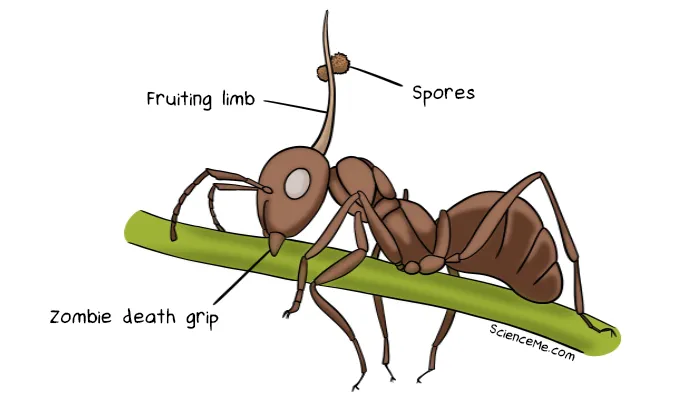
A zombie ant infected with a Cordyceps fungus.
The Science of The Last of Us
Launched on PS3 in 2013, The Last of Us features a novel species of Cordyceps that infects humans. Initially spreading as spores in the human food chain, the fungus invades the brain and central nervous system, rewriting behaviour and consuming the host until nothing remains but a shambling, violent, fungi-ridden husk. Depending on the infection stage, you evolve into one of six nightmare subclasses:
 |
Runners - fast, irritable, lightly mushroomed. |
 |
Stalkers - lurking, croaking, wall-fusing enthusiasts. |
 |
Clickers - blind, cranially blossomed echolocators. |
 |
Shamblers - slow units with flingable acid bulbs. |
 |
Bloaters - powerful, overgrown armoured tanks. |
 |
The Rat King - twisted fusion of clickers, stalkers, and a bloater. |
In HBO's adaptation of The Last of Us, John Hannah plays epidemiologist Dr Neuman, who coolly warns of a fungal apocalypse. Let's break down his claims one by one.
| CLAIM | REALITY |
"There's a fungus that infects insects... floods it with hallucinogens, thus bending the ant's mind to its will." |
True. Cordyceps secretes neuroactive compounds, including toxins and possibly hallucinogens, to override an insect's survival drive and force it to die in an ideal spot for spore dispersal. |
"The fungus starts to... devour its host from within, replacing the ant's flesh with its own." |
True. Cordyceps kills the ant intentionally as part of its reproductive strategy. Its goal is not to keep you alive, just to turn your corpse into a high-rise spore cannon. |
"Fungi cannot survive if their host's internal temperature is over 94 degrees." |
True. Many fungi struggle above 30–35°C (86–95°F), although heat-tolerant opportunistic species exist. One benefit of being warm-blooded is to keep rampant fungal growth at bay, with fevers our antifungal flamethrowers. |
"Currently, there are no reasons for fungi to evolve to be able to withstand higher temperatures. But what if... the world were to get slightly warmer?" |
Mixed. Fungi do face selective pressure from warm-blooded hosts, but not enough to adapt wholesale to human body temperatures (yet). As the environment warms, mutated heat-loving fungi spread and become more mammal-compatible. This doesn't produce zombies, but it does mean more jock itch. |
"One gene mutates and an Ascomycete, Candida, Ergot, Cordyceps, Aspergillus, any one of them could become capable of burrowing into our brains and taking control." |
False. To manipulate a human brain, a fungus has to make sophisticated interactions with the nervous system that are well beyond the scope of a single gene mutation. It needs to develop new biological pathways like: host recognition, adhesion structures, immune evasion, mammal-specific toxins, nutrient extraction, and nervous system interfaces. |
"Billions of puppets with poisoned minds permanently fixed on one unifying goal: to spread the infection to every last human alive by any means necessary." |
False. Humans are annoyingly good at breaking the chain of transmission. Also, most people in TLOU die before they become vectors. They bleed out, suicide, or are hacked to pieces by Joel Fucking Miller. In the spore-free TV version it would be even easier. |
"And there are no treatments for this. No preventatives, no cures. They don't exist. It's not even possible to make them." |
False. We have multiple antifungal drug classes (azoles, echinocandins, polyenes) that mess with cell membrane synthesis and cell wall integrity to kill fungi. They're preventative, too: immunocompromised patients routinely take prophylactic antifungals. Humanity does have more options than to die screaming. |
Why Cordyceps Can't Infect Humans
The strongest argument against a Cordyceps pandemic is host specificity. The Cordyceps lineage is the product of 100-200+ million years of evolution. Today, there are 750+ species of Cordyceps, each specialised to a single host species. This only emerged through prolonged evolutionary periods of molecular trial-and-error.
One doesn't simply... generalise a mind-controlling parasitic lifestyle to an entirely new animal phylum with a single gene mutation.
To infect humans, Cordyceps would need to evolve new:
- Chemical tools to hijack the human nervous system.
- Strategies to evade our more complex immune system.
- Enzymes to process human tissues.
- Chemical recognition to target human cells.
- Behaviours to be compatible with our biology.
- Gene regulation to promote their parasitism.
They won't achieve this through a single gene mutation, but a cascade of mutations which can only be unlocked through co-evolution.
It boils down to this: the last common ancestor of humans and insects lived 500 million years ago. We've really gone our separate ways since then, demonstrated by such facts as bees have stingers in their asses and we don't.
This vast genetic gap makes it a lot harder for Cordyceps to cross the species barrier from arthropods to humans.
Unless some AI-powered gain-of-function lab gets bored, it's astronomically unlikely Cordyceps will evolve to zombify humans. It simply takes a long, long time for natural selection to unlock these molecular passwords.
Real Fungal Threats to Humans
Now, don't relax! There are still fungi that remain a threat. The world is teeming with an estimated 2-4 million species of species of fungi, around 600 of which are pathogenic and symbiotic varieties associated with humans.
Your body is colonised with complex populations of fungi mostly in the gut, lungs, skin, and mucosal surfaces. This mycobiome is part of your larger microbiome of bacteria, fungi, viruses, and their runaway genes.
Your immune system performs a fine balancing act to tolerate commensal fungi while defending against full-on invasion.
Every time you step into nature, you inhale thousands of fungal spores which are potential threats to your wellbeing. Likewise, when you share towels or high five your gym buddy, fungi transfer skin-to-skin. Most of the time that's fine, because you're warm-blooded and have a working immune system.
But it's not perfect. Fungal invasion, or mycosis, tends to occur on the skin, hair, nails, mucous membranes, or lungs. Athlete's foot, jock itch, and ringworm are all caused by the overgrowth of moulds called dermatophytes. The resulting skin infections aren't quite on a level with clickers, but they are pretty gross.
Aspergillus fumigatus is inhaled daily by everyone, but only immunocompromised people get deadly lung infections from it. Symptoms include chest pain and coughing up blood, but zero zombification.
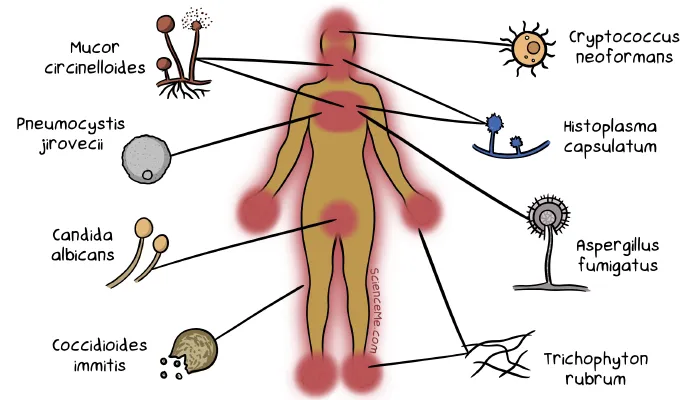
Where fungi tend to attack the human body.
Climate change may already be shaping fungal evolution. In 2009, a novel fungus called Candida auris emerged on multiple continents almost simultaneously, suggesting an environmental shift that enabled it to tolerate human body temperature. The Candida family of fungi usually cause yeast infections, but this one is different.
The novel Candida auris thrives at human body temperature, spreads person-to-person, is multi-drug resistant, causes severe infections in the bloodstream, and is often fatal in immunocompromised patients.
After COVID, the WHO released a fungal priority list. There are 19 pathogens on the list, with four of critical concern:
 |
Cryptococcus neoformans - An opportunistic soil yeast causing lung and brain infections. |
 |
Candida auris - An invasive drug-resistant, hospital-nightmare yeast. |
 |
Aspergillus fumigatus - An environmental mould that causes severe lung disease. |
 |
Candida albicans - A common, symbiotic yeast that turns lethal when uncontrolled. |
Final Thoughts
The Last of Us builds a captivating world and I'm hooked so long as it remains fiction. In reality, Cordyceps fungi are highly specialised for arthropods and took millions of years to get that way.
To infect humans with a single gene mutation is like dropping a typewriter down the staircase of the Empire State Building and expecting Romeo and Juliet at the bottom.
Could it happen? Theoretically, yes. But it requires a timeframe so vast that both parasite and host would have evolved into new species.
Until then, enjoy the game. And don't share towels.
Written and illustrated by Becky Casale. If you like this article, please share it with your friends. If you don't like it, why not torment your enemies by sharing it with them? While you're at it, subscribe to my email list and I'll send more science articles to your future self.
